| Columns Retired Columns & Blogs |
Excellent review- JVS.
No doubt, 2020 is the year of the Integrated Amp!
I tested the Musical Fidelity M8xi with my Audio Precision SYS2722 system (see the January 2008 "As We See It"). I first preconditioned the amplifier by following the CEA's recommendation of operating it at one-eighth the specified power into 8 ohms for 30 minutes. At the end of that time, the top panel was very warm, at 109.6°F (43.1°C) and the heatsinks were too hot to touch, at 162.1°F (72.3°C). I then started performing my usual thermal stress test by running the amplifier at one-third power into 8 ohms for an hour. However, I cut the test short after 20 minutes, as the top panel's temperature was already 118.1°F (47.8°C) and that of the heatsinks 172.7°F (78.2°C) and I was concerned that I would damage the amplifier. Despite the massive heatsinks along its sides, the Musical Fidelity amplifier doesn't have quite enough thermal capacity for its power rating.
I looked first at the Musical Fidelity's performance via its line inputs. While the balanced inputs offered a maximum gain at the speaker outputs of 36.6dB into 8 ohms, the unbalanced inputs offered a significantly higher 43.8dB. Usually, a single-ended input offers 6dB lower gain than a balanced input. The maximum gain at the variable preamplifier outputs was 12.76dB, balanced in to balanced out, and 13.6dB, unbalanced in to unbalanced out. At the fixed-level, unbalanced line output, the gain was 0.4dB for the single-ended inputs and 7.24dB for the balanced inputs. The amplifier preserved absolute polarity at all sets of outputs for both unbalanced and balanced input signals. The volume control operates in accurate 0.5dB steps.
The single-ended line input impedance met the specification, at 25k ohms at 20Hz and 1kHz, though it dropped slightly to 21k ohms at 20kHz. The balanced input impedance was lower than specified, at 17.8k ohms across the audioband. The preamplifier output impedance was an appropriately low 48 ohms, single-ended, and 96 ohms, balanced, though the latter rose to 189 ohms in the low bass.
The Musical Fidelity's output impedance at the loudspeaker terminals was a little higher than usual for a solid-state design, presumably due to the bridged output stage. It measured 0.27 ohms at 20Hz and 1kHz, rising to 0.33 ohm at 20kHz. (The figures include the series impedance of 6' of spaced-pair loudspeaker cable.) The modulation of the amplifier's frequency response, due to the Ohm's law interaction between this source impedance and the impedance of my standard simulated loudspeaker, was ±0.2dB (fig.1, gray trace). The response into an 8 ohm resistive load (fig.1, blue and red traces) was down by 3dB just above 100kHz, which correlates with the Musical Fidelity's accurate reproduction of a 10kHz squarewave into that load (fig.2). Note that the very low bass in fig.1 rolls off a little, reaching –0.5dB at 20Hz and –1.5dB at 10Hz. Fig.1 was taken with the volume control set to its maximum; neither the frequency response nor the excellent channel matching changed at lower settings of the volume control.

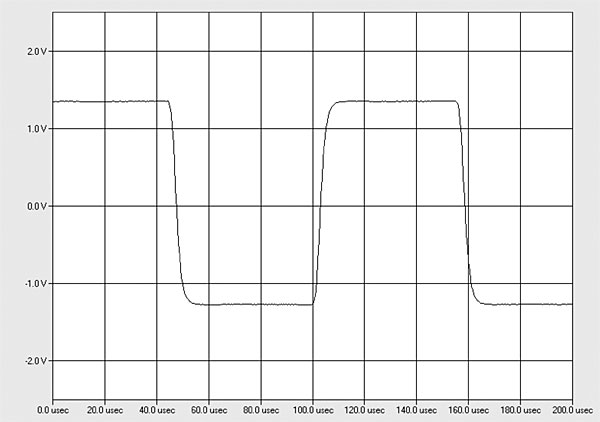
Channel separation (not shown) was good, at >80dB in both directions below 4kHz and still 67dB at the top of the audioband. The Musical Fidelity's unweighted signal/noise ratio, taken with the unbalanced line inputs shorted to ground and the volume control at its maximum setting of "100.0," was a little disappointing at 55.9dB ref. 2.83V into 8 ohms (average of both channels). This ratio improved to 64.3dB when the measurement bandwidth was restricted to the audioband and to 67dB when A-weighted. The level of the background noise, which included spuriae at 60Hz and its even- and odd-order harmonics, depended on the setting of the volume control. This can be seen in fig.3, which shows the low-frequency spectrum of the amplifier's output while it drove 1kHz at 2.83V into 8 ohms with the volume control set to "100.0" (cyan and magenta traces) and to "80.0" (blue and red traces). Reducing the volume control setting by 20dB lowers the levels of the noise-floor components by around 13dB.
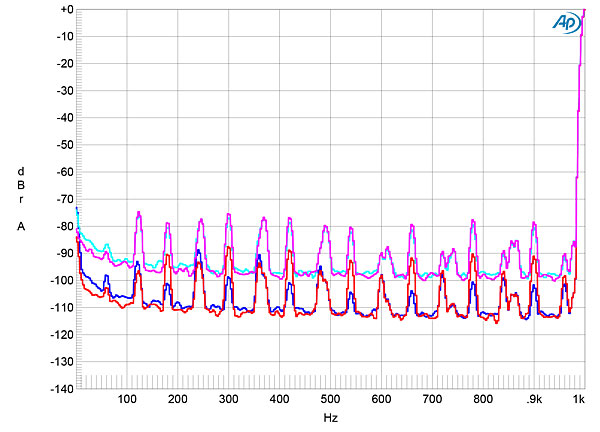
With both channels driven, the M8xi didn't quite meet its specified maximum power into 8 ohms of 550Wpc (27.4dBW), clipping (defined as 1% THD+noise) at 500Wpc (27dBW, fig.4). However, I don't hold the wall AC voltage constant for the tests; it measured 120V with the amplifier idle but dropped to 116.2V when the amplifier was clipping into 8 ohms. The Musical Fidelity clipped at 650Wpc into 4 ohms (25.1dBW, fig.5). (The wall voltage dropped to 113.5V with the amplifier delivering 650Wpc into this load.) Even with the volume control set to "90," the THD+N reading was dominated by noise below a few tens of watts, so I plotted how the THD+N percentage changed with frequency at 20V, which is equivalent to 50W into 8 ohms, 100W into 4 ohms, and 200W into 2 ohms. The distortion was very low into 8 ohms (fig.6, blue and red traces). However, it was higher into 4 ohms (cyan and magenta traces) and even more so into 2 ohms (gray trace), though still below 0.1% across the audioband.
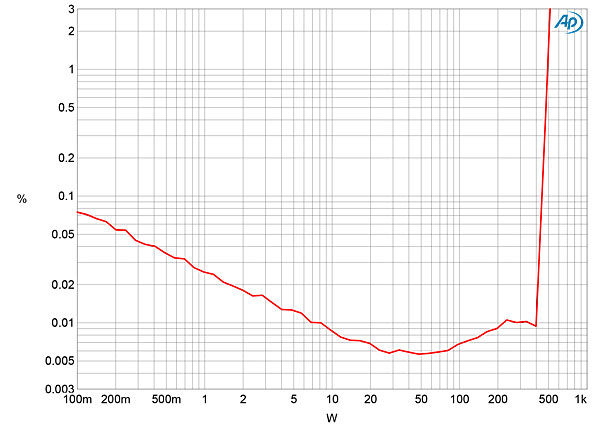
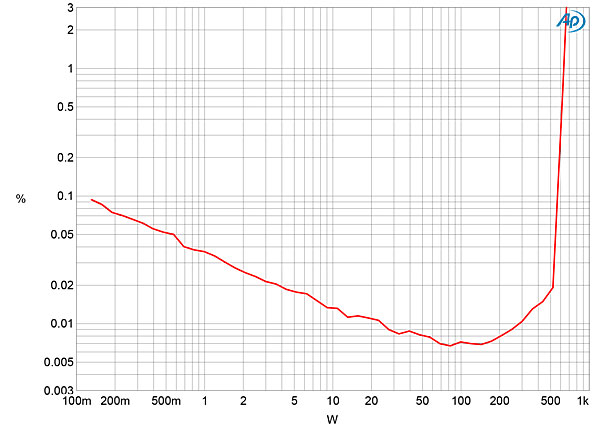
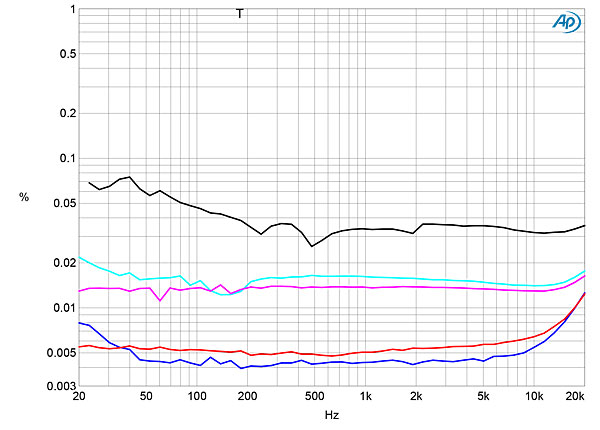
The distortion was predominantly the subjectively benign third harmonic (fig.7). The volume control was set to its maximum for this measurement, and even with 32 captures averaged, the distortion waveform (bottom trace) was still overlaid with noise. Higher-order harmonics are present at lower levels, and the left channel had some second harmonic present (fig.8, blue trace). When the M8xi drove an equal mix of 19 and 20kHz tones at 30W into 8 ohms (fig.9), high-order intermodulation products all lay below –76dB (0.06%), and the second-order difference product at 1kHz can't be seen above the noise floor, even though I had the volume control set to "80.0" for this measurement to reduce the level of the noise.
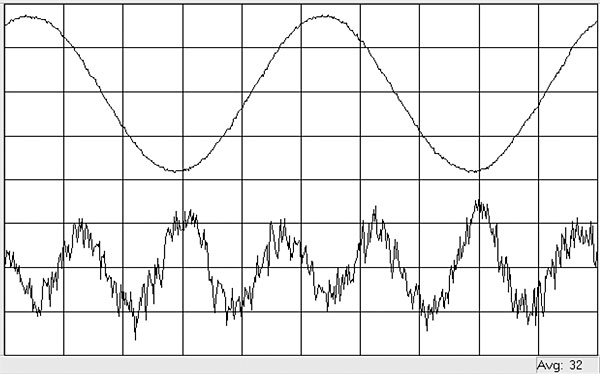
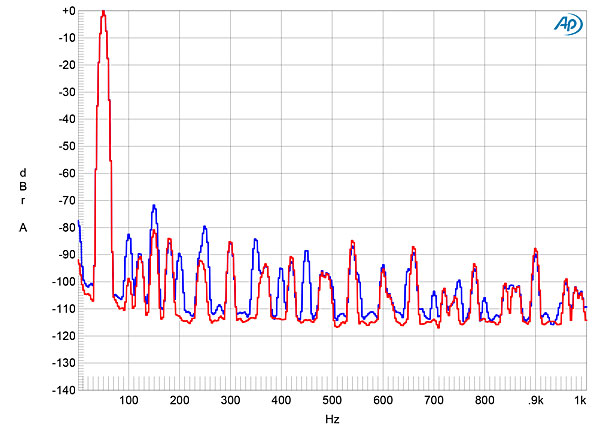
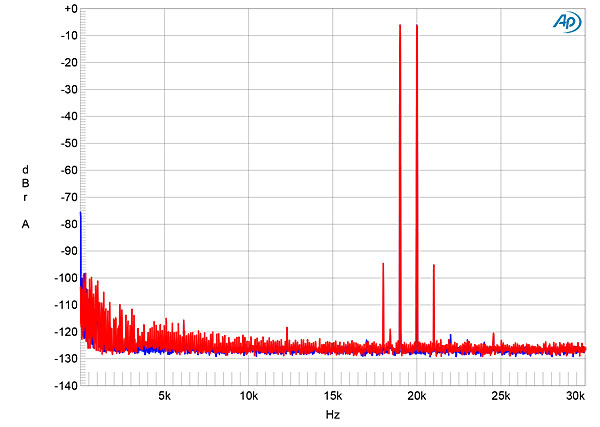
The Musical Fidelity M8xi has optical and coaxial S/PDIF digital inputs, as well as a USB port. The coaxial inputs locked to data sampled up to 192kHz, the optical inputs to sample rates up to 96kHz. Apple's USB Prober utility identified the Musical Fidelity as "MF M8xi" from "Project." The USB port operated in the optimal isochronous asynchronous mode, and Apple's AudioMIDI utility revealed that the M8xi accepted 16- and 24-bit integer data sampled at all rates from 44.1kHz to 192kHz. The USB and S/PDIF inputs all preserved absolute polarity.
With the volume control set to "100.0," a 1kHz digital signal at –20dBFS resulted in an output level of 31.05V, which is equivalent to 120.5W into 8 ohms. As my measured clipping power into 8 ohms was 500W, which is equivalent to a voltage of 63.25V, it appears that the M8xi's digital inputs have around 14dB too much gain. The –20dBFS digital signal results in levels of 1.908V at the balanced preamplifier output, 953.6mV at the unbalanced preamplifier output, and 191.1mV at the fixed-level single-ended line output. To avoid damaging the Musical Fidelity's power amplifier stage with high-level digital signals, I performed all the measurements of the digital inputs' performance at the fixed-level outputs with the volume control set to "0.0."
The Musical Fidelity's impulse response with 44.1kHz data (fig.10) indicates that the reconstruction filter is a conventional linear-phase type, with time-symmetrical ringing on either side of the single sample at 0dBFS. With 44.1kHz-sampled white noise (fig.11, red and magenta traces), the M8xi's response rolled off sharply above 20kHz, reaching full stop-band suppression just above half the sample rate (vertical green line). An aliased image at 25kHz of a full-scale tone at 19.1kHz (blue and cyan traces) can't therefore be seen, though the distortion harmonics of the 19.1kHz tone are visible above the ultrasonic noise floor. The third harmonic is the highest in level at just above –60dB (0.1%). Peculiarly, the 19.1kHz tone and its third and fifth harmonics are accompanied by low-level, ±2kHz sidebands. The M8xi's digital-input frequency response was flat in the audioband with then a sharp rolloff just below half of each sample rate (fig.12).
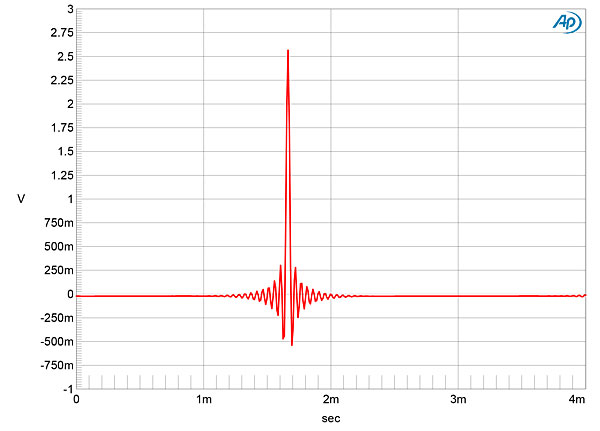
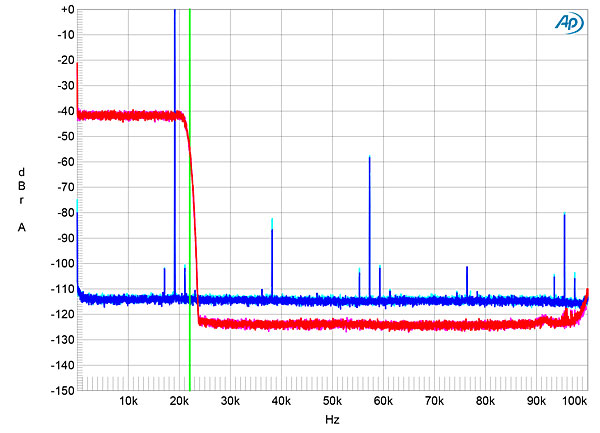
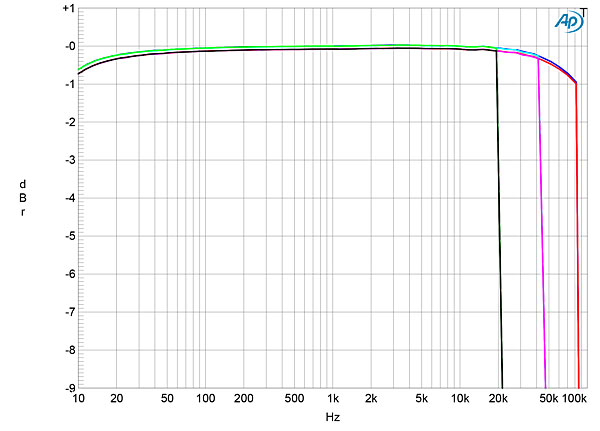
Channel separation via the digital inputs was >100dB below 1kHz, but crosstalk rose linearly to –75dB at the top of the audioband, due to capacitive coupling between the channels. When I increased the bit depth from 16 to 24 with a dithered 1kHz tone at –90dBFS (fig.13), the noise floor components dropped by around 15dB, which implies that the M8xi offers between 18 and 19 bits' worth of resolution. However, a large number of low-level, power-supply–related spuriae were present in the noise floor. With undithered data representing a tone at exactly –90.31dBFS (fig.14, the three DC voltage levels described by the data were well-resolved. With undithered 24-bit data, the result was a somewhat noisy sinewave (fig.15).

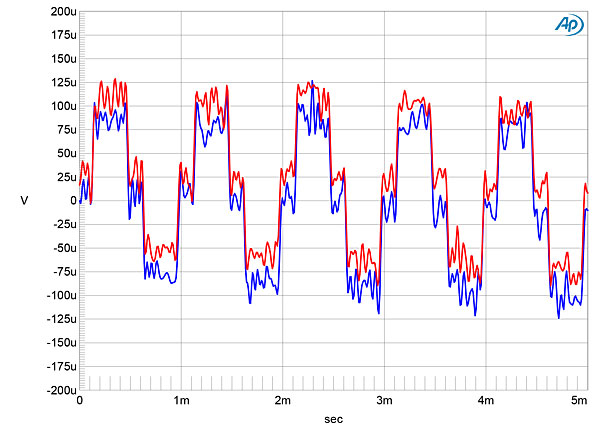
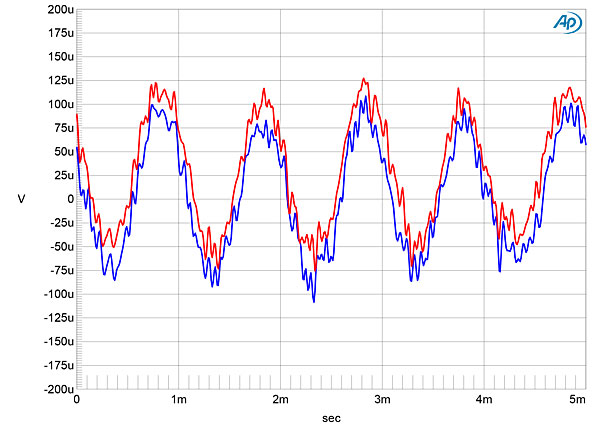
I tested the M8xi for its rejection of word-clock jitter via both its TosLink and USB inputs. Though all the odd-order harmonics of the 16-bit J-Test signal's LSB-level, low-frequency squarewave were at the correct levels (fig.16, sloping green line), the spectral spike that represents the high-level tone at exactly one-quarter the sample rate was significantly broadened at its base. This suggests that the Musical Fidelity's digital inputs are affected by random, low-frequency jitter. With 24-bit J-Test data (fig.17), no jitter-related sidebands were present, but the spectral broadening could still be seen.
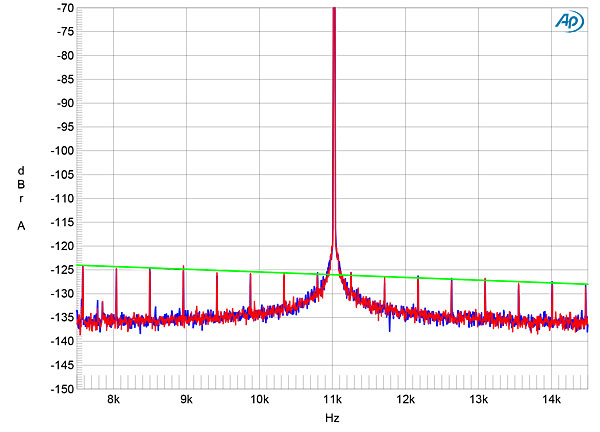
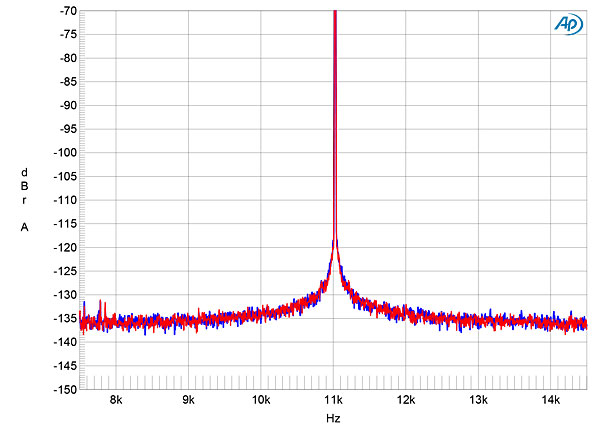
Musical Fidelity's M8xi offers high power and low distortion. Though its noise floor with the volume control set to its maximum was higher in level than I was expecting, the amplifier's high gain, especially with digital data and single-ended analog input signals, means that the volume control will never be used anywhere near its maximum.—John Atkinson

Excellent review- JVS.
No doubt, 2020 is the year of the Integrated Amp!


... $100K for a DAC, power amp(s) and speakers and for a similar total cost, would the better system choice be the combination of a dCS DAC, a pair of D'Agostino Progression Mono power amps and a pair of Wilson Alexia 2 speakers OR this Musical Fidelity M8xi integrated amp (with its built-in DAC) and a pair of Wilson Alexx speakers?
Should we wait to make this sort of determination until JVS has had the opportunity to evaluate a Hegel H590?

A speaker cannot make front end components deliver more than they can produce; all that better speakers can do is reveal more of what the front end (including cables) produces. With that in mind, I think the answer is self-evident.

... to view the system hierarchy. It sounds much like the viewpoint, espoused for many decades by Linn, that the source component makes the most significant contribution to overall sound quality, followed by the amplifier, and finally the speakers.
Conversely, some speaker manufacturers would suggest that the development of electronic components - as opposed to transducers - has now reached a level such that the point of diminishing returns is reached at a relatively low price point. Thus, a much greater proportion of the system budget ought to be allocated to the speakers.
In the future, if JVS has the opportunity to evaluate another high-power integrated amp (with a built-in DAC), such as the aforementioned Hegel H590, perhaps it can be arranged for Wilson to supply a sample of their Alexx speakers, so that this matter can be resolved in a somewhat more definitive manner.

You wrote: "It sounds much like the viewpoint, espoused for many decades by Linn, that the source component makes the most significant contribution to overall sound quality, followed by the amplifier, and finally the speakers."
However, that is not what I said. In response to a specific question about a a specific budget and a specific set of components, all of which was named, I made a call. Truth be told, I am not one for either making blanket chicken or the egg pronouncements or subscribing to absolute laws, including the so-called "law of diminishing returns." As I've stated on other occasions, that law is relative to the taste and budget of the listener. What some would label or even dismiss as a "diminishing return," others will embrace as an engineering gift and a portal to audiophile nirvana.

That law *is* relative to the taste and budget of the listener, making it less of a law and more of a method.
As examples, I've consistently found that once a speaker is good enough, the mind largely forgets it and finds nearly endless audible upstream elements to optimize. I've seen this play out for others. I've heard virtually identical assessments from users of similar equipment to confirm this, right down to the vernacular and descriptors.
This suggests that as an assortment of types, speakers toe that threshold non-linearly, and that some serve this phenomenon while others do not. They either do or they do not recede into the perceptual background for the other components to capture the ear. And since this plays out almost regardless of the size of the speaker, we conclude that the principle holds *across* the primary differentiator among loudspeakers, which is their size and therefore loudness.
And that in turn reinforces the view that it may be the front ends *of these better systems* that matters most, and from there we get into everything from cables to topologies to recordings.
A reverse is also true, at least from experience and observation but not from conventional wisdom: Electronics are not perfected - refuting the subjective assumption that they largely are and now budgets should be devoted more to speakers - at least in the sense that they can be predicted on paper. This also calls into question the wisdom of recommending more expensive speakers when we know that they differ more by their size than by their resolution. You can find the same tweeter in a 6" speaker and in a 7-driver 3-way, for example, and you can easily argue that the simpler 6" 2-way speaker can deliver a more believable recreation in ways other than power and scale. Increasing speaker budgets is less meaningful than refining the systems driving genuinely great ones.
Apparently there's a prevalent envious reductionism of a sort among theorists that prompts them to instinctively question expensive components, compare the basic data they generate, and draw conclusions not based in informed experience. To say that X + Y at $2500 must "blow away" the listener's value of A + B at $25,000 is bias. It's another reason rules are hard to nail down and the most objective analysis is the "subjective" reviewer.
The taste and budget of the listener is a variable but not as a function of excellent sound, which stands apart, is quite self-evident, and isn't terribly subjective. It's a variable in that some never understand great sound while others are immediately impressed by it when they hear it. None of the latter camp I've met subscribe to the rules or the purported valuations of those who make them.


... embrace as an "engineering gift" a power amplifier, such as you use, whose $38K/pr. cost encroaches on the price spectrum of luxury motor vehicles.
How much of the cost of that amplifier is attributable to the ostentatious power meter (designed to emulate the appearance of a certain luxury timepiece)? Likewise, for the elaborate chassis - as opposed to the electronic components contained therein, especially when the performance of those components includes an output impedance sufficiently high as to result in audible variations in frequency response when connected to the load presented by a typical loudspeaker.
If you want to see a power amplifier that might somehow be worthy of being deemed an "engineering gift", then cast your vision toward the ($3K) Benchmark AHB2 or, possibly, the ($2K) NAD C 298 which incorporates the latest Purifi amplifier modules. Neither unit is much to look at, but should that be of any concern for sound reproduction equipment?

"means that the volume control will never be used anywhere near its maximum.—John Atkinson"
You know him JA, is Antony Michaelson a gain junkie?
This seems to be common place with MF, their gear usually has massive gain structure's going on, and why probably to me they always seem to sound on the sterile side of things.
Cheers George

Hi, thanks for posting a detailed review. Can anyone please clarify whether this amplifier has any issue with excess heating? The gain on the digital input, which was noted as too much, how does that affect? What exactly it means? Also, can you suggest a good MM phono preamp for this amplifier? Would appreciate your comments.

I thought that Jason was going to compare the Musical Fidelity vs the Yamaha, after the heated discussions of the recent review of the latter (127 comments!), taking into account that both are at the same price level.
The readers deserve a proper explanation.
Can you enlighten us a bit, Jason?

I would take the M8xi in a heartbeat over the A-S3200.

Thanks Jason, straight to the point. Adding a good phono stage of around $ 1000 (Graham Slee and Leema Acoustics come to mind) we arrive at the price of the Yamaha.
That is a clear and concise help.
You are very nice, continue your good writing.

Hello,
In the second paragraph you say, "the fabled parting of the Red Sea that allowed the people of Israel to escape from Egypt, the prospect of using the money saved to buy a few coveted yellow bricks proved so tempting that I gleefully mixed mythologies as I prepared myself to ignore the possible consequences of my metaphorical sins."
Fabled ? Mythologies ?
I am not accusing you, and perhaps I am not correctly understanding your intent or meaning / context, but the parting of the Red Sea is not a fable and Christianity is not mythology. Please fully clarify your thoughts on these two items as they come across as diminishing of the validity of the event and reducing a valid faith to mere myth.
Thank you.

Comparing M8xi with a $100K system, not really helpful. I decided to purchase this anyway, based on the other dozen positive reviews and I have noticed it sounds very good, and does NOT get hot in EXTREMELY LOUD usage. I can drive 96dB SPL (6m away) from my Focal 936 K2's into my 25 x 28' x 11' ceiling room, and it barely draws 400W at the wall. Not hot at the fins either. Cool and relaxed. Smokin' loud though. It idles at 118W. That's way under half my Pass X250.5 which this replaces. This one has more verve, clarity and dynamix than Pass, for a good bit less money too, and guess what--the DAC is great. Can't hear or MEASURE a diff with audible signal from my Auralic, or Topping DX7 Pro. Why you think you need a $28000 D'Agostino DAC is beyond me. It's effectively a DSP preamp giving you different sound, but not a purer signal. That's a simple fact. I like jewelry, but come on man, y'all seem just a bit snooty around the edges on this review. Haha. Who's putting sponge in the bells I once rung?

Great review factual and to the point and you stayed true to your writing style. I understood that this is a great Integrated amplifier even in comparison to a system costing vastly more. I don't expect you to cheap down your system or make changes to your life just for me, I do expect when you review to base your comments on how a particular item sounds in respect to your reference system. Good job. I got what I needed from your excellent review.
M~

I have the M8xi, it's a sheer beast, my unit does not get very warm or hot, but I have it in an open rack. I find my A3.5 which is modest in comparison, still has a much warmer tone over all in comparison and sounds equally as good at similar volume levels. I am also finding out just sheer wattage isn't always needed as the Moonriver Reference Int. Amp (low wpc)I have sonically sounds better to my ears, but these are totally different kinds of Int. Amps, depends on what your looking for and what your needs are.